Tracking the performance of your tweets through analytics can help you develop a more effective Twitter marketing strategy.
One of the most important metrics to track is impressions. It gives you a rough idea of how many people have seen your tweets. Combining that with other metrics like interactions can reveal your content reach.
At Typefully, we believe that every brand should be deriving insights from Twitter analytics. That’s why we’ve developed an analytics platform that provides you with deeper insights than Twitter’s own dashboard.
In this article, we’ll introduce you to Twitter impressions, discuss why they’re important and give you some tips on how to improve them. Let’s go!
What are Twitter Impressions?
Impressions refer to the number of times your tweet has appeared on a user’s timeline.
Your tweet's impressions are counted when it's shown to your followers, as well as when it appears in search results or when it's retweeted.
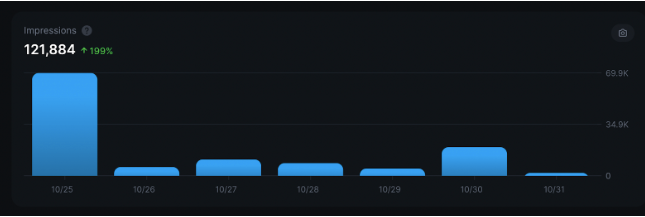
If your tweet has been shown to 1,000 users, you would have 1,000 impressions.
Note: impressions only count the number of times your tweet has been delivered to a user’s timeline.
It doesn’t track how many people have read your tweet. Impressions analytics makes no distinction between a user who interacts with your tweet and someone who’s just scrolled past it.
Interactions are measured as engagements, which include the total number of clicks, likes and retweets.
Why should you track Twitter impressions?
Impressions tell you how far your tweet has gone. For organic content, impressions give you a rough estimate of how successful your tweet was in breaking into users’ timelines. An uptick in impressions can be an indication that Twitter's discovery algorithm likes your content.
If you’ve paid to promote your tweet, impressions can be used alongside profile visits or engagements to estimate the cost-effectiveness of your campaign. Impressions can also be used to find out your engagement rate. This roughly tells you how much your viewers are enjoying your tweets.

For example, a low engagement rate means your followers are seeing your tweets, but aren’t interacting with them.
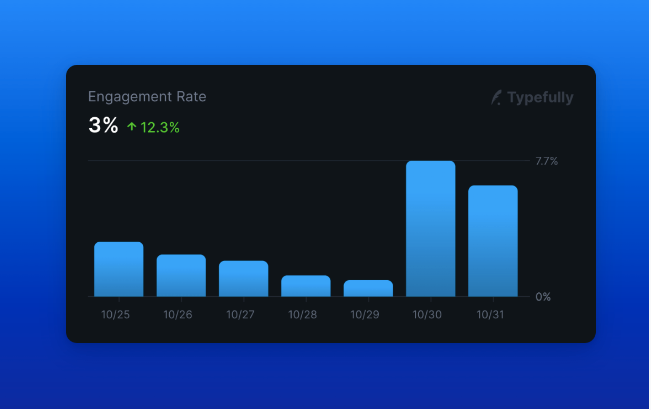
Typefully’s analytics dashboard calculates your engagement rate for you. It even tracks how this changes over time. This helps you gauge whether changes to your content strategy are compelling users to interact with your tweets.
Want to explore engagements further? Read our complete guide on the topic here.
How do you track Twitter Impressions?
There are two main ways to count your tweets’ impressions. You can either use Twitter’s built-in analytics dashboard or a third-party analytics tool like Typefully.
Let’s walk you through how to find out your impressions using both methods.
Using Twitter Analytics
Twitter has some built-in analytics tools for creators and brands. Remember, Twitter Analytics isn’t enabled by default.
To get started, firstly make sure you’re signed in to your chosen account on twitter.com. Then, head over to analytics.twitter.com.
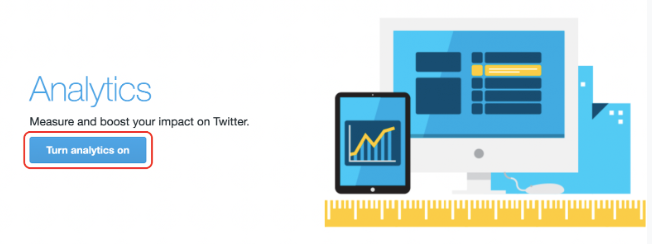
Click “Turn analytics on” to enable analytics.
Your dashboard gives you some useful information about your popular tweets.
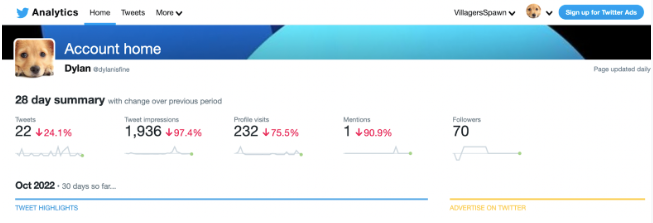
Here, we can see your Tweet impressions over the last 28 days.
To get a closer look, hit Tweets in the top toolbar.
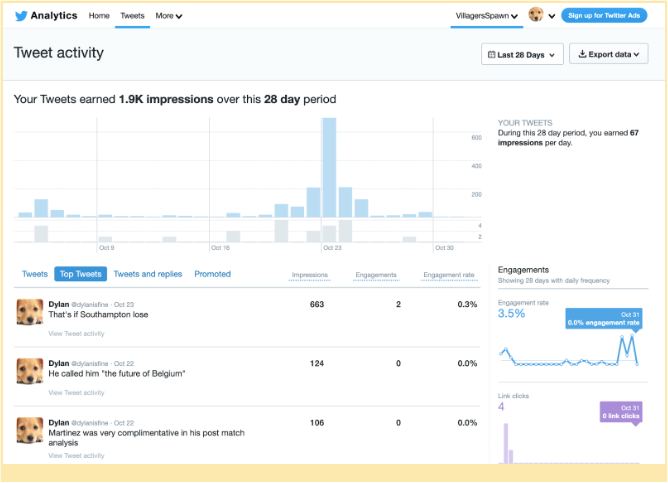
Here, we can see how your impressions have changed over the observation period and how each individual tweet has performed.
By default, you’ll be shown impressions over a 28-day period. Just hit the calendar button at the top to change this time period.
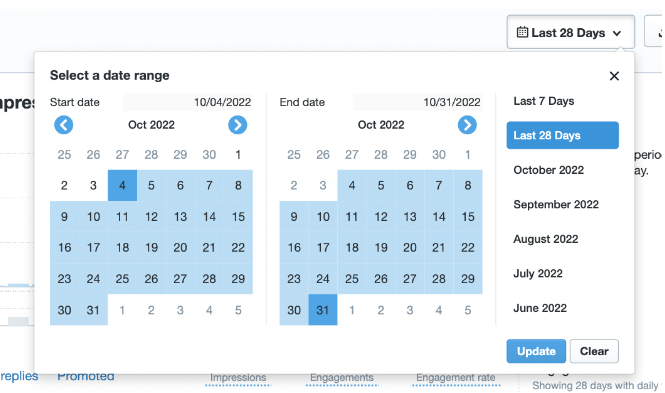
But Twitter Analytics can only show data from a three-month period. You can’t, for example, gain a simple overview of your top tweets for the whole year.
There are other limitations to Twitter’s Analytics tool. In fact, the tool has been fairly neglected by Twitter and has fallen behind third-party tools that use the Twitter API.
You can’t see how your impressions or engagement rates change within a day. Twitter has even removed their conversion tracking feature entirely.
Using Typefully
That’s why we recommend using a third-party tool to track your analytics. Typefully connects through Twitter’s API to securely pull your impressions and engagement data.
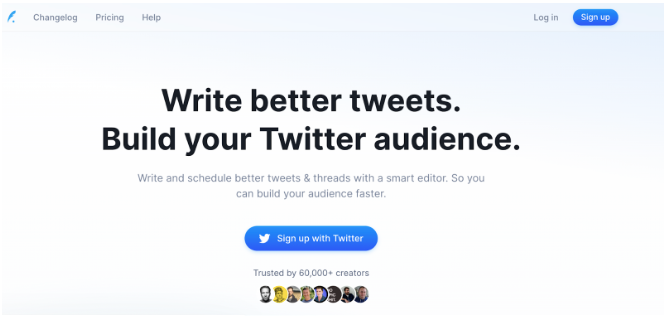
Getting started is simple! Head to typefully.com and sign up with Twitter.
Then, navigate to the Grow tab to see your Twitter impressions data.
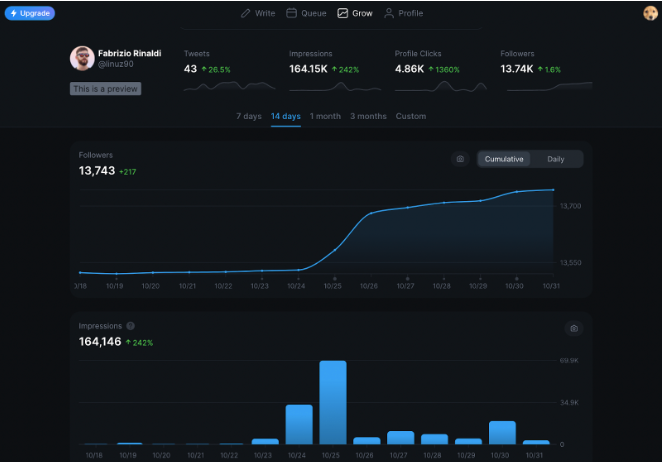
You can get a basic overview of your impressions over a set time period. Unlike Twitter’s tool, you can make this period as long as you like.

This allows you to track how impressions change throughout the year. Do your impressions spike during the holiday season? Or are your readers more active in the summer months?
Scroll down the Grow page to see how your individual tweets stack up.
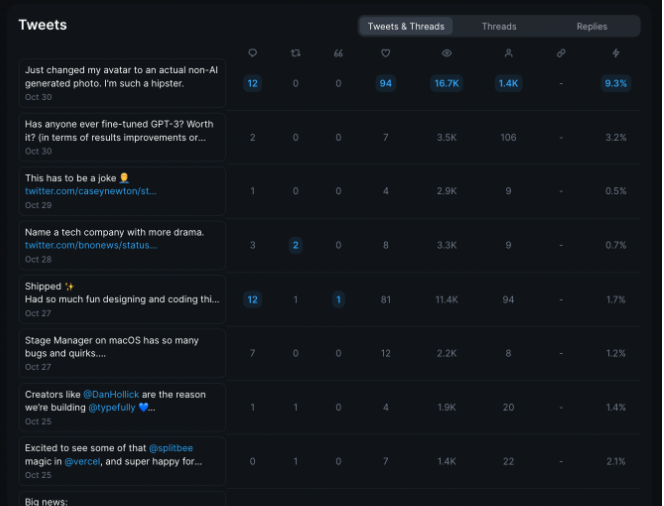
What else can you do with Typefully’s analytics dashboard? Our best time to tweet feature maps out how engagement changes throughout the day.
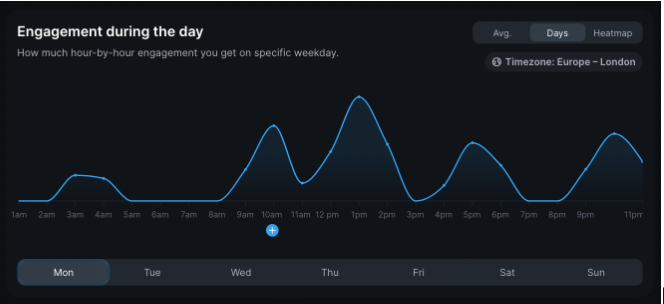
Finally, you can see how your profile conversions change over time.
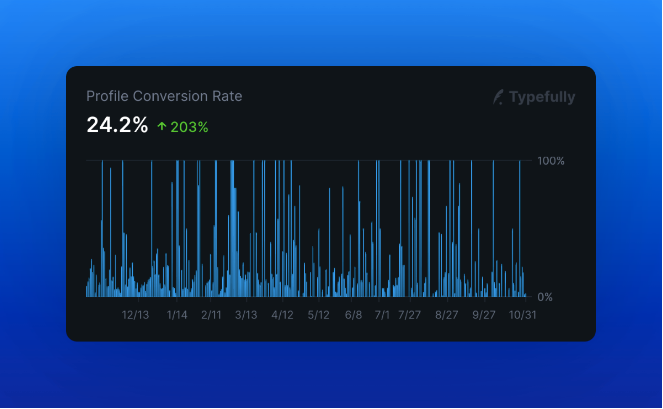
Best Practices for Boosting Twitter Impressions
Now that we’ve covered how to track your Twitter impressions and why it’s important to track them, how can you increase them?
Here are some of our top tips for boosting your tweet impressions:
Follow a consistent schedule & post regularly
This may seem obvious but to get people to see your tweets, you’ll need to tweet regularly. We’d recommend going further by following a tight schedule and posting at specific times of the day to maximize your reach.
There are two main reasons for this:
- Twitter’s algorithm favors brands and accounts that tweet consistently and regularly. If your schedule is sparse and erratic, Twitter may be unwilling to recommend your content to new viewers.
- Followers expect regular, useful tweets. If you don’t tweet regularly, or don’t follow a clear schedule, they may unfollow you.
Certain times of the day often garner better results. For example, tweeting at noon can ensure your tweet is ready for when your followers get off work. Posting at 2 am will likely provide unfavorable results.
Of course, the best time to tweet varies depending on your audience and type of content. Using our engagement during the day tracker can help you find the best time slots for releasing content on Twitter.
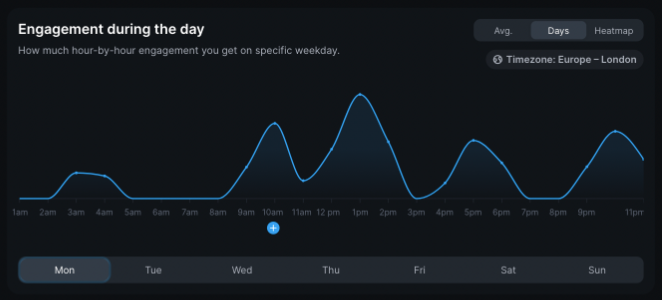
You can then easily schedule your tweets based on this information.
For example, Amtrak regularly schedules their tweets to release at noon.

Want to find out why? Check out our full guide on the best time to tweet here.
Consider collaborating with influencers and other brands
To demonstrate the effectiveness of partnering with other accounts, let’s introduce you to a metric called potential reach.
This refers to the total number of accounts it’s possible for your tweets to reach.
The potential reach of an account that doesn’t partner with others or get any retweets would be limited to its follower count.
Let’s say your account of 1M followers partners with an influencer with 2M followers. If this influencer retweets your content, your basic potential reach will now be 3M. It’s as simple as that!
For example, as part of his brand deal with Nike, footballer Cristiano Ronaldo regularly retweets any content mentioning his CR7 line of products.

We recommend finding an influencer or partner brand within your niche. You can find creators to collaborate with through influencer directories like Collabstr.
Pick the right Twitter topics
A key way that accounts may discover your content is through topics.
Whilst very few readers scroll through topic pages, using relevant tags can help guide who Twitter should recommend your content to. We recommend using competitor research to find interesting new topics to target. Find out what’s currently popular by using Twitter’s trending tabs or use an SEO keyword tool like Ahrefs to find interesting new search queries.
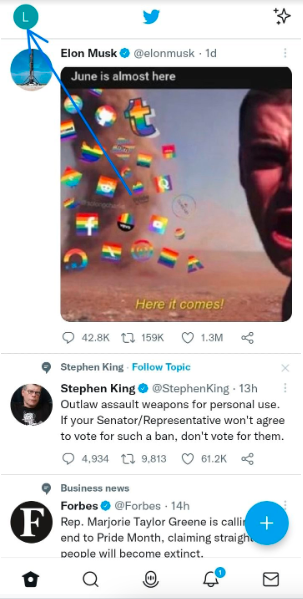
How do you target these trending topics? In general, you’ll just need to mention the main keyword in your tweet in order to appear on the topic feed.
If your topic or even a hashtag gains enough traction, it may appear in the Trending tab. This is a great way to attract a new audience to your account.
Write engaging threads/tweetstorms
Using Twitter’s threads feature is a great way to boost impressions, and more importantly conversions.
Threads refer to multiple tweets that are grouped together on profiles and timelines. They allow brands and creators to delve into topics in more detail.
How do threads impact impressions?
TweepsMap found that threads can increase your impressions by up to 2,417%! Twitter sees threads as more valuable content, and readers tend to engage with these more.
In that same experiment, TweepsMap saw a 160% boost in engagements.
Writing and publishing threads can be difficult without a good thread creator and scheduler. Typefully makes it easy to write engaging threads, and publish them when needed.
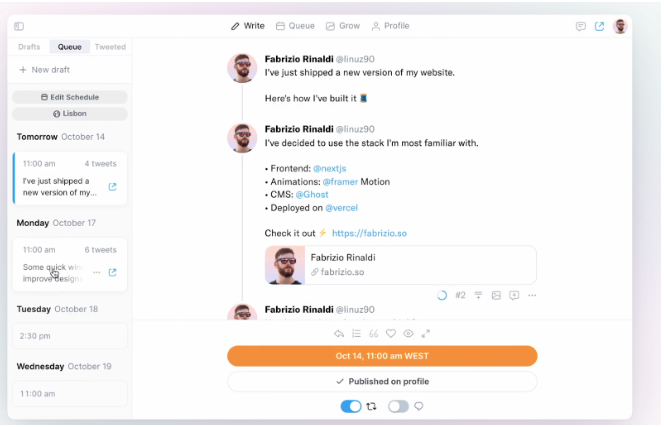
Use the icons to manually add images and quotes to your thread sections, or drag and drop them.
Typefully keeps track of your message characters to ensure you're within the limit and will split them into constituent tweets for you.
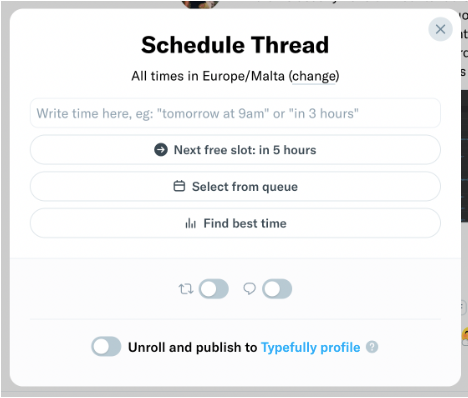
You can then publish threads in pre-set time slots or use Typefully’s analytics to find the best time to post.
Crack Twitter Marketing with Typefully
The secret to great impressions and engagement is using data-driven insights to guide your Twitter marketing strategy.
Typefully’s Grow tab gives you all the data and metrics you need to write better-performing tweets.
Want to give threads a crack? Our brilliant thread editor, tweet scheduler and awesome collaboration tools simplify this process dramatically! So, why not supercharge your Twitter today? Get started with Typefully and unlock your full marketing potential!


